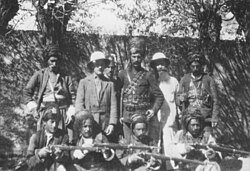Simko Shikak revolt
| Simko Shikak Revolt | |||||||
|---|---|---|---|---|---|---|---|
| Part of 1921 Persian coup d'état, Kurdish movement in Iran and Assyrian genocide | |||||||
 Simko (center) |
|||||||
|
|||||||
| Belligerents | |||||||
|
Rebels
|
|||||||
| Commanders and leaders | |||||||
| Seyyed Taha Shamzini |
Amir Ershad Reza Khan Mirpanj |
||||||
| Strength | |||||||
| 1,000 (early stage) – 5,000 (later stage) Several hundred Ottoman soldiers and Turkish mercenaries |
10,000 | ||||||
| Casualties and losses | |||||||
| 2,500 killed, captured and wounded | 200 killed, captured and wounded | ||||||
| Total: 5,000 killed | |||||||
Revolt suppressed:
Rebels
Amir Ershad
The Simko Shikak revolt refers to an armed Ottoman-backed tribal Kurdish uprising against the Qajar dynasty of Iran from 1918 to 1922, led by Kurdish chieftain Simko Shikak from the Shekak tribe.
After Brigadier-General Reza Khan deposed the Qajars in an 1921 coup, he defeated Simko Shikak as well as several prominent rebel commanders such as Kuchik Khan and Colonel Pessian during the Iranian events of 1921. The Shikak rebellion resulted in some 5,000 killed, including many Assyrian civilians, who were massacred by Simko's forces.
In March 1918, under the pretext of meeting for the purpose of cooperation, Simko arranged the assassination of the Assyrian Nestorian patriarch, Mar Shamon, ambushing him and his 150 guards, as Mar Shimon was entering his carriage. The patriarchal ring was stolen at this time and the body of the patriarch was only recovered hours later, according to the eye-witness account of Daniel d-Malik Ismael.
After the murder of Mar Shimun, the Hakkari Christians took revenge on the Muslim population of Salmas and most of the villages of Salmas County, while Simko and his men massacred Assyrians in Khoy. Christian brigades terrorized Christians as well as Muslims. A missionary described this period as a reign of terror for Muslims hard to imagine. Simko also instigated the massacre of 1,000 Christians in Salmas.
...
Wikipedia
